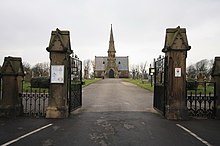Layton Cemetery

The entrance to Layton Cemetery, with the mortuary chapel
|
|
| Shown within Blackpool | |
| Details | |
|---|---|
| Established | 1873 |
| Location | Blackpool, Lancashire |
| Country | England |
| Coordinates | 53°49′46″N 3°02′03″W / 53.8295°N 3.0343°WCoordinates: 53°49′46″N 3°02′03″W / 53.8295°N 3.0343°W |
| Type | Public |
| Owned by | Blackpool Council |
| Size | 30 acres (12 ha) |
Layton cemetery is a graveyard located at Talbot Road in Blackpool, Lancashire in England. It was opened in 1873 when Blackpool parish church was replete with burying. The site encompasses 30 acres (120,000 m2), having been regularly expanded during its history. It is administered by Blackpool Council. A number of memorials in the cemetery are executed in Portland stone.
The cemetery was designed and laid out by Garlick, Park and Sykes, architects of Preston. Originally there were three mortuary chapels, Anglican, Catholic and Non-Conformist but only the Anglican remains. There was a lodge at the entrance which provided a residence and office for the custodian. The original part of the cemetery was surrounded a stone wall, topped with iron railings with a double iron gate at the entrance. These structures are extant. A World War I memorial is centrally situated.
In the 1930s, the cemetery was rapidly nearing capacity and therefore a new cemetery and crematorium were opened, known as Carleton Crematorium and Cemetery. Layton Cemetery is now replete but interments are permitted in existing graves.
Layton Cemetery contains the graves of 139 Commonwealth service personnel of World War I and 39 of World War II, besides, from the latter war, 26 airmen of the Polish Air Force (whose headquarters in exile were in Talbot Square in the town), and one airman of the Royal Yugoslav Air Force.
Samuel Laycock's grave
Gerald Richardson's grave
Dick Barlow's grave
George Washington Williams' grave
Edwin Hughes' grave
Alfred Tysoe's grave
Spencer Timothy Hall's grave
Ada Boswell's grave
...
Wikipedia

